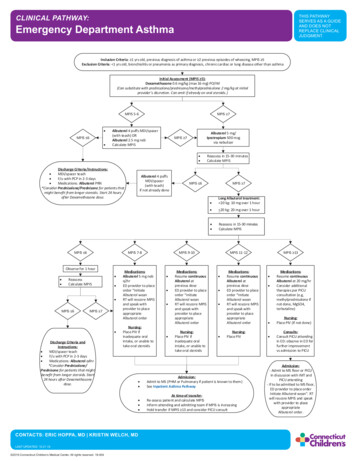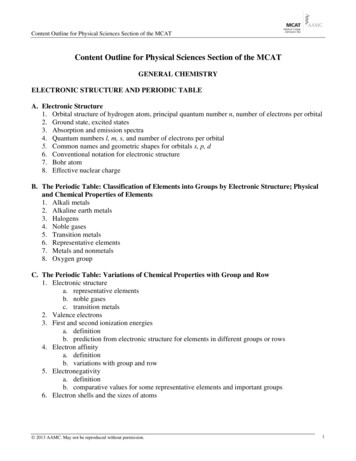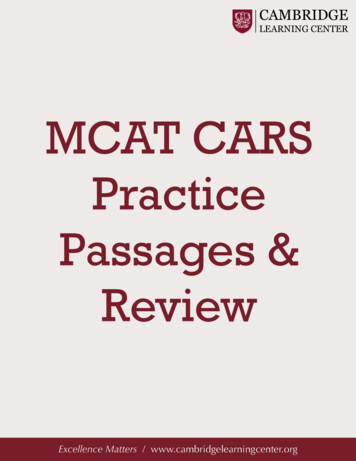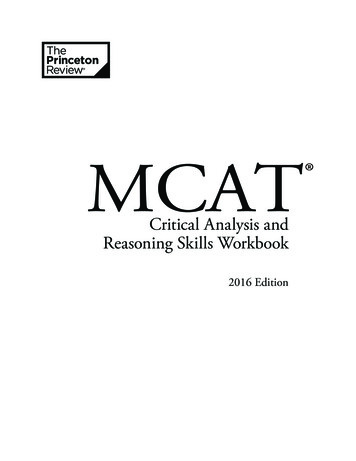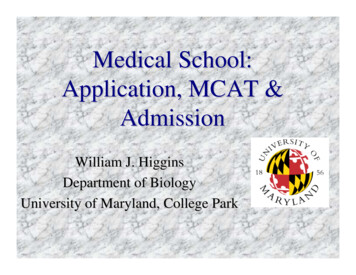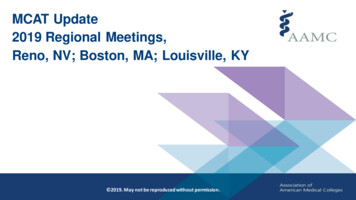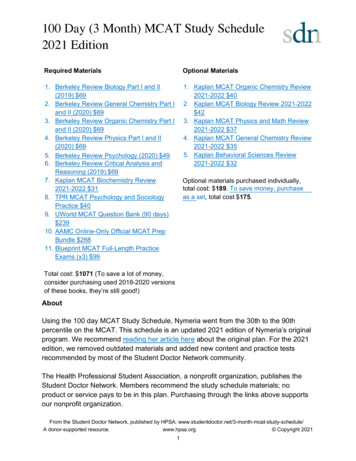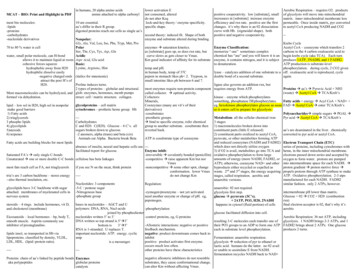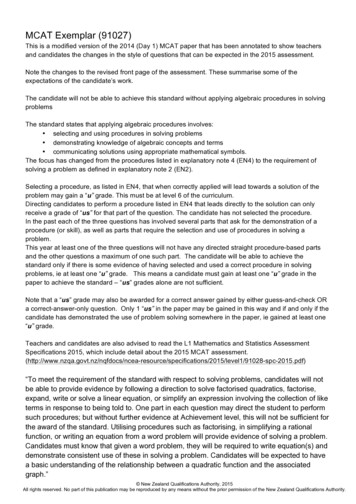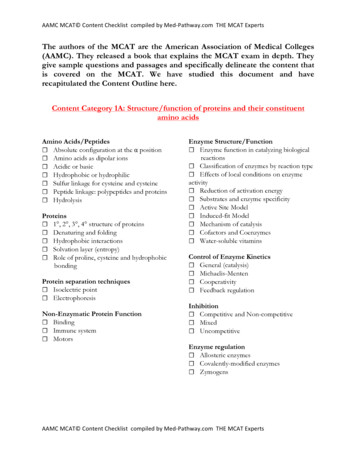
Transcription
AAMC MCAT Content Checklist compiled by Med-Pathway.com THE MCAT ExpertsThe authors of the MCAT are the American Association of Medical Colleges(AAMC). They released a book that explains the MCAT exam in depth. Theygive sample questions and passages and specifically delineate the content thatis covered on the MCAT. We have studied this document and haverecapitulated the Content Outline here.Content Category 1A: Structure/function of proteins and their constituentamino acidsAmino Acids/Peptides Absolute configuration at the α position Amino acids as dipolar ions Acidic or basic Hydrophobic or hydrophilic Sulfur linkage for cysteine and cysteine Peptide linkage: polypeptides and proteins HydrolysisProteins 1 , 2 , 3 , 4 structure of proteins Denaturing and folding Hydrophobic interactions Solvation layer (entropy) Role of proline, cysteine and hydrophobicbondingProtein separation techniques Isoelectric point ElectrophoresisNon-Enzymatic Protein Function Binding Immune system MotorsEnzyme Structure/Function Enzyme function in catalyzing biologicalreactions Classification of enzymes by reaction type Effects of local conditions on enzymeactivity Reduction of activation energy Substrates and enzyme specificity Active Site Model Induced-fit Model Mechanism of catalysis Cofactors and Coenzymes Water-soluble vitaminsControl of Enzyme Kinetics General (catalysis) Michaelis-Menten Cooperativity Feedback regulationInhibition Competitive and Non-competitive Mixed UncompetitiveEnzyme regulation Allosteric enzymes Covalently-modified enzymes ZymogensAAMC MCAT Content Checklist compiled by Med-Pathway.com THE MCAT Experts
AAMC MCAT Content Checklist compiled by Med-Pathway.com THE MCAT ExpertsContent Category 1B: Transmission of genetic information from the gene tothe proteinNucleic Acid Structure and Function Nucleotides and nucleosides Sugar phosphate backbone Pyrimidine, purine residues Deoxyribonucleic acid (DNA): doublehelix,Watson–Crick model of DNA structure Base pairing specificity: A with T, G withC Function in transmission of geneticinformation DNA denaturation, reannealing,hybridizationDNA Replication and Repair Mechanism of replication: separation ofstrands, specific coupling of free nucleicacids Semi-conservative nature of replication Specific enzymes involved in replication Origins of replication, multiple origins ineukaryotes Replicating the ends of DNA moleculesThe Genetic Code Central Dogma: DNA RNA The triplet code Codon-anticodon relationship Degenerate code, wobble pairing Missense, nonsense codons Initiation, termination codons Messenger RNA (mRNA)Transcription tRNA and rRNA Mechanism of transcription mRNA processing in eukaryotes, introns,exons Ribozymes, spliceosomes, small nuclearribonucleoproteins, small nuclear RNA Evolutionary importance of intronsTranslation Roles of mRNA, tRNA, rRNA Role and structure of ribosomes Initiation, termination co-factors Post-translational modification ofproteinsEukaryotic Chromosome Organization Chromosomal proteins Single copy vs. repetitive DNA Supercoiling Heterochromatin vs. euchromatin Telomeres, centromeres Repair during replication Repair during replication Repair of mutations Telomeres, centromeresGene Expression in Prokaryotes Jacob-Monod Model Gene repression in bacteria Positive control in bacteriaControl of Gene Expression in Eukaryotes Transcriptional regulation DNA binding proteins, transcriptionfactors Gene amplification and duplication Post-transcriptional control, basic conceptofsplicing (introns, exons) Cancer as a failure of normal cellularcontrols,oncogenes, tumor suppressor genes Regulation of chromatin structure DNA methylation Non-coding RNAsRecombinant DNA and Biotechnology Gene cloning and cloned gene expression Restriction enzymesAAMC MCAT Content Checklist compiled by Med-Pathway.com THE MCAT Experts
AAMC MCAT Content Checklist compiled by Med-Pathway.com THE MCAT Experts DNA libraries Generation of cDNA Hybridization and Polymerase ChainReaction Gel Electrophoresis and SouthernBlotting DNA sequencing Analyzing gene expression Determining gene function Stem cells Applications of DNA technology: genetherapy, pharmaceuticals, forensic evidence,environmental cleanup, agricultureContent Category 1C: Transmission of heritable information from generationto generation and the processes that increase genetic diversityMendelian Genetics Phenotype and genotype Gene and locus Allele: single and multiple Homozygosity and heterozygosity Wild-type Recessiveness Complete dominance Co-dominance Incomplete dominance, leakage,penetrance,expressivity Hybridization: viability Gene poolMeiosis and Other Factors AffectingGenetic Variability Significance of meiosis Important differences between meiosisandmitosis Segregation of genes Independent assortment Linkage Recombination Single and double crossovers Synaptonemal complex TetradSex-linked characteristics Few genes on Y chromosome Sex determination Cytoplasmic/extranuclear inheritanceMutation Error in DNA sequence Types of mutations: random, translationerror, transcription error, base substitution,inversion, addition, deletion, translocation,mis-pairing Advantageous vs. deleterious mutation Inborn errors of metabolism Relationship of mutagens to carcinogens Genetic drift Synapsis or crossing-over mechanism andgenetic diversityAnalytic Methods Hardy–Weinberg Principle Testcross (Backcross; parent, F1 and F2generations) Gene mapping: crossover frequencies Biometry: statistical methodsEvolution Natural selection Fitness concept Selection by differential reproduction Concepts of natural and group selection Evolutionary success as increase inpercent representation in the gene pool of thenext generationSpeciation Polymorphism Adaptation and specialization InbreedingAAMC MCAT Content Checklist compiled by Med-Pathway.com THE MCAT Experts
AAMC MCAT Content Checklist compiled by Med-Pathway.com THE MCAT Experts Outbreeding Bottlenecks Evolutionary time as measured by gradualrandom changes in genomeContent Category 1D: Principles of bioenergetics and fuel moleculemetabolismPrinciples of Bioenergetics Bioenergetics/thermodynamics Free energy/Keq and Equilibrium constant Relationship of the equilibrium constantandΔG Le Châtelier’s Principle Endothermic/exothermic reactions Free energy: G, Spontaneous reactionsandΔG Phosphoryl group transfers and ATP ATP hydrolysis ΔG 0 ATP group transfers Half-reactions in biological redoxreactions Soluble electron carriers FlavoproteinsCarbohydrates Nomenclature and classification Absolute configuration Cyclic structure and conformation Epimers and anomers Hydrolysis of the glycoside linkage Mono, di and polysaccharidesGlycolysis, Gluconeogenesis, and thePentose Phosphate Pathway Glycolysis (aerobic), substrates andproducts Feeder pathways: glycogen, starchmetabolism Fermentation (anaerobic glycolysis) Gluconeogenesis, Pentose phosphatepathway Net molecular and energetic results ofrespiration processesPrinciples of Metabolic Regulation Regulation of metabolic pathways Maintenance of a dynamic steady state Regulation of glycolysis andgluconeogenesis Metabolism of glycogen Regulation of glycogen synthesis andbreakdown of Allosteric and hormonalcontrol Analysis of metabolic controlCitric Acid Cycle Acetyl-CoA production Reactions of the cycle, substrates andproducts Regulation of the cycle Net molecular and energetic results ofrespiration processesMetabolism of Fatty Acids and Proteins Description of fatty acids Digestion, mobilization, and transport offats Oxidation of fatty acids - Saturated andunsaturated fats Ketone bodies Anabolism of fats Biosynthesis of lipids and polysaccharides Metabolism of proteinsOxidative Phosphorylation Electron transport chain and oxidativephosphorylation, substrates and products,general features of the pathway Electron transfer in mitochondria NADH, NADPHAAMC MCAT Content Checklist compiled by Med-Pathway.com THE MCAT Experts
AAMC MCAT Content Checklist compiled by Med-Pathway.com THE MCAT ExpertsFlavoproteinsCytochromesATP synthase, chemiosmotic couplingProton motive forceNet molecular and energetic results ofrespiration processes Regulation of oxidative phosphorylation Mitochondria, apoptosis, oxidative stress Hormonal Regulation & Integration ofMetabolism Higher level integration of hormonestructureand function Tissue specific metabolism Hormonal regulation of fuel metabolism Obesity and regulation of body massCategory 2A: Assemblies of molecules, cells, and groups of cells within singlecellular and multicellular organismsPlasma Membrane General function in cell containment Composition of membranes Lipid components Phospholipids (and phosphatids) Steroids Waxes Protein components Fluid mosaic model Membrane dynamics Solute transport across membranes Thermodynamic considerations Osmosis Colligative properties, osmotic pressure Passive transport Active transport Sodium/potassium pump Membrane channels Membrane potential Membrane receptors Exocytosis and endocytosisIntercellular junctions Gap junctions Tight junctions DesmosomesMembrane-Bound Organelles andDefiningCharacteristics of Eukaryotic Cells Defining characteristics of eukaryoticcells: membrane bound nucleus, presence oforganelles, mitotic divisionNucleus Compartmentalization, storage of geneticinformation Nucleolus: location and function Nuclear envelope, nuclear poresMitochondria Site of ATP production Inner and outer membrane structure Self-replication Lysosomes: membrane-bound vesiclescontaining hydrolytic enzymesEndoplasmic reticulum Rough and smooth components Rough endoplasmic reticulum site ofribosomes Double membrane structure Role in membrane biosynthesis Role in biosynthesis of secreted proteinsAAMC MCAT Content Checklist compiled by Med-Pathway.com THE MCAT Experts
AAMC MCAT Content Checklist compiled by Med-Pathway.com THE MCAT Experts Golgi apparatus: general structure androle in packaging and secretion Peroxisomes: organelles that collectperoxidesCytoskeleton General function in cell support andmovement Microfilaments: composition and role incleavage and contractility Microtubules: composition and role insupport and transport Intermediate filaments, role in support Composition and function of cilia andflagella Centrioles, microtubule organizing centersTissues Formed From Eukaryotic Cells Epithelial cells Connective tissue cellsContent Category 2B: The structure, growth, physiology, and genetics ofprokaryotes and virusesCell Theory History, development, impact on biologyClassification and Structure of ProkaryoticCells Prokaryotic domains: Archaea andBacteria Major classifications of bacteria by shape:Bacilli, Spirilli or Cocci Lack of nuclear membrane and mitoticapparatus Presence of cell wall in bacteria Flagellar propulsion, mechanismGrowth and Physiology of ProkaryoticCells Reproduction by fission High degree of genetic adaptability,acquisition of antibiotic resistance Exponential growth Existence of anaerobic and aerobicvariants Parasitic and symbiotic ChemotaxisGenetics of Prokaryotic Cells Existence of plasmids, extragenomicDNA Transformation: incorporation intobacterial genome of DNA fragments fromexternal medium Conjugation Transposons (including eukaryotic cells)Virus Structure General structural characteristics (nucleicacidand protein, enveloped and nonenveloped) Lack organelles and nucleus Structural aspects of typical bacteriophage Genomic content - RNA or DNA Size relative to bacteria and eukaryoticcellsViral Life Cycle Self-replicating biological units thatreproduce within host cell Generalized phage and animal virus lifecycles Attachment to host, penetration of cellmembrane or cell wall, and entry of viralgenetic material Use of host synthetic mechanism toAAMC MCAT Content Checklist compiled by Med-Pathway.com THE MCAT Experts
AAMC MCAT Content Checklist compiled by Med-Pathway.com THE MCAT Expertsreplicate viral components Self-assembly and release of new viralparticles Transduction: transfer of genetic materialby viruses Retrovirus life cycle: integration into hostDNA, reverse transcriptase, HIV Prions and viroids: subviral particlesContent Category 2C: Processes of cell division, differentiation, andspecializationMitosis and mitotic structures Mitotic process: prophase, metaphase,anaphase, telophase, interphase Centrioles, asters, spindles Chromatids, centromeres, kinetochores Nuclear membrane breakdown andreorganization Mechanisms of chromosome movement Phases of cell cycle: G0, G1, S, G2, M Growth arrest Control of cell cycle Loss of cell cycle controls in cancer cellsBiosignalling Oncogenes, apoptosisReproductive System Gametogenesis by meiosis Ovum and sperm - differences informationand morphology Relative contribution to next generation Reproductive sequence: fertilization,implantation, development, birthEmbryogenesis Stages of early development (order andgeneral features of each stage) Fertilization Cleavage Blastula formation Gastrulation First cell movements Formation of primary germ layers(endoderm,mesoderm, ectoderm) Neurulation Major structures arising out of primarygermlayers Neural crest Environment–gene interaction indevelopmentDevelopment – Cell specialization Determination Differentiation Tissue types Cell–cell communication in development Cell migration Pluripotency: stem cells Gene regulation in development Programmed cell death Existence of regenerative capacity invarious species Senescence and agingAAMC MCAT Content Checklist compiled by Med-Pathway.com THE MCAT Experts
AAMC MCAT Content Checklist compiled by Med-Pathway.com THE MCAT ExpertsContent Category 3A: Structure and functions of the nervous and endocrinesyst
The authors of the MCAT are the American Association of Medical Colleges (AAMC). They released a book that explains the MCAT exam in depth. They give sample questions and passages and specifically delineate the content that is covered on the MCAT. We have studied this document and have recapitulated the Content Outline here. Content Category 1A .


